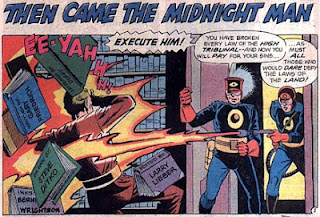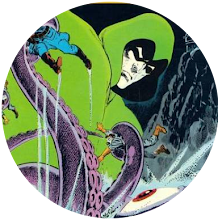Life's never easy when you're half-man half-salad, and issue #3 of Atlas Comics' Morlock seems determined to prove it beyond all doubt.
When it begins, we find Morlock still roaming the countryside and - having killed virtually everyone he's ever met - still bemoaning his fate.
He's on his way to see a scientist called Whitlock who he believes can help him with his random homicidal tendencies.
How he knows about this Whitlock, we're never told. How he finds him, we're never told.
Unfortunately, Morlock's not the only one to find him because the dreaded thought police have also located the scientist and, when Morlock gets there, he finds them setting fire to the man.
Morlock of course reacts as any of us would. He turns into a killer tree and eats the thought police's leader.
Fortunately, despite having been set on fire, Whitlock doesn't die.
Instead, when Morlock's returned to normal, the scientist befriends him and shows him his underground base from which he's all set to lead his followers in a somewhat ad hock revolution that mostly involves him putting on a mask and declaring it's a revolution.
Unfortunately for that revolution, within minutes, the thought police burst in and start killing everyone, just as Morlock once more turns into a killer tree.
So, Whitlock shoots Morlock dead and then, showing the never-say-die spirit any revolutionary needs, prepares to blow up himself, his base and all his followers.
You have to give it to Atlas, there's not many comics companies that'd think of killing a strip's star in the third issue.
But then again, did they really intend to leave him dead? It should be pointed out that Morlock's a plant not a person and so there's no guarantee a bullet would kill him like it would the rest of us. And it's a safe bet they weren't really going to have Whitlock blow up himself and all his followers, or there wouldn't have been an awful lot left to write about in the next issue.
Apart from the seeming death of Morlock, the comic's main point of interest is of course that its art's by Steve Ditko and Berni Wrightson which isn't quite as exciting a combo as it sounds, as, a bit of extra visual depth aside, it looks pretty much like Steve Ditko always looks.
On the writing front, Michael Fleisher's no longer on board, which means no females get eaten. But anyone fearing a shortage of cannibalism and humourless bloodshed need fear not, as his replacement Gary Friedrich serves up more of the same, with Morlock having a remarkable knack of blundering into the people he needs to blunder into for the story to happen, and showing no personality beyond complaining about his fate.
Strangely, at no point are we told why Whitlock survived being set on fire, and it doesn't seem we're even expected to be curious about it.
I said, when I reviewed issue #1, that Morlock was one of the few Atlas strips that had potential. And it had.
Don't get me wrong. I don't mean Morlock himself had the potential to be a great super-hero. With his tendency to kill everyone he encounters, he clearly didn't, but the basic set-up of an inhuman man on the loose in a dystopian world did at least have the potential to create interesting stories.
Sadly, it never lasted long enough, nor seemed ambitious enough to give us them. Who knows what magic the likes of Don McGregor and Craig Russell could have conjured up if handed the same concept?
Still, with the introduction of the Midnight Men, there're clear signs Atlas were at least trying to expand the narrative and take the strip into whole new directions.
Sadly though, there were to be no more issues for Morlock; and we're doomed to never know just what fate would have had in store for the titular terror and ourselves.
Subscribe to:
Post Comments (Atom)












































































2 comments:
"He turns into a killer tree and eats the thought police's leader."
That's the strangest sentence I've read this morning.
And I've been doing nothing but read strange sentences.
I think this is my favourite and most memorable issue of the old Atlas comics. (To be completely honest, I've never owned or read that many, mind you.) Ditko's trademark shapes and minimalism suits the title well, as does Wrightson's inking. The scenes on the grounds outside the thought police's complex are particularly good. Bonus points must be awarded for their retelling of Morlock's origin, which--unlike the initial account in No 1--does not involve scenes of him being born already wearing his costume.
Post a Comment